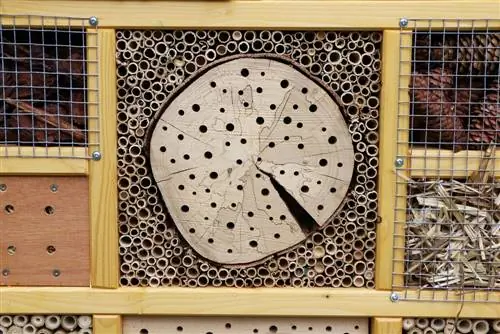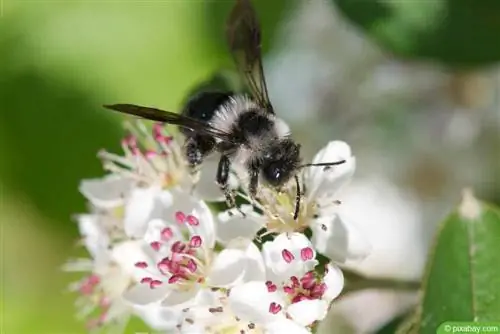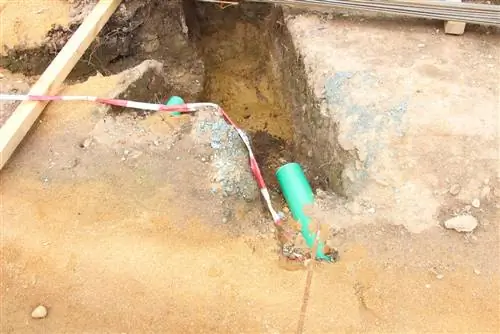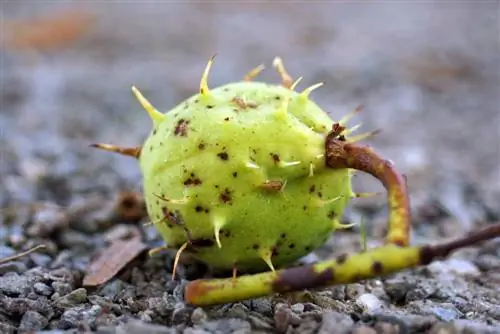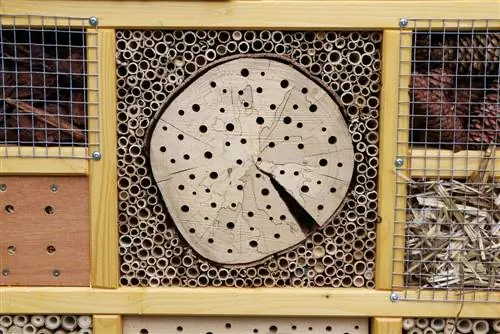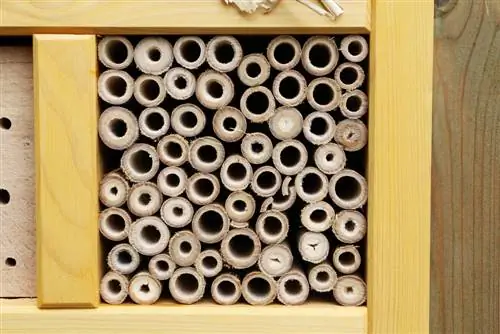- Author admin [email protected].
- Public 2023-12-17 03:39.
- Last modified 2025-01-24 12:45.
Wild bees are welcome guests in the natural garden. The busy insects pollinate ornamental and useful plants and offer the whole family a fascinating insight into a unique world. A self-built wild bee house is the first step towards the successful settlement of wild bees. In this guide you will find out everything you need to know about the best materials and the optimal construction method. Practical tips show how easy it is to breed wild bees yourself.
Wild bees are solitary creatures
Of the more than 500 wild bee species in Germany, 95 percent prefer a solitary lifestyle. This aspect is a key differentiator between wild bees and honey bees. A wild bee house therefore has little in common with the beekeeper's classic beehive. Please read briefly in advance about the unique way of life of wild bees.
Overwintering in a cocoon
Male and female bees of most wild species overwinter as pupa or imago (full insect), well protected in a cocoon. As soon as they have hatched, a female takes care of the offspring all by herself after mating. Male wild bees are not involved in the breeding business. As hermit bees, wild bees do not carry out brood care in a division of labor, as honey bees do. Over the course of its four to eight week life, the wild bee gradually creates up to 30 brood cells, fills them with pollen and nectar as provisions and lays a single egg in them. In the carefully sealed cell, the larva feeds on the food supply, pupates and hibernates in it to start its own family the next year. There is therefore usually no contact between the generations.
Tip:
Wild bees are essential for pollinating fruit trees. They bravely brave the cold and drizzle to pollinate the flowers from March onwards in search of food for their offspring. At this time, sensitive honey bees are still waiting for mild, warm and dry spring weather.
Important criteria for a wild bee house
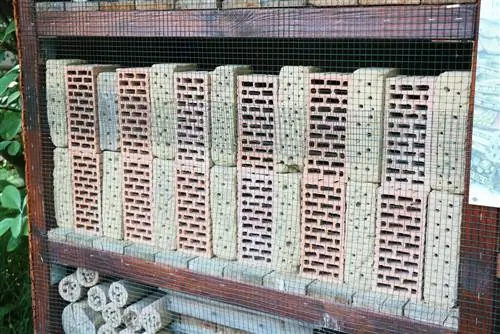
The short excursion into the lifestyle of most wild bee species makes it clear that a wild bee house must meet special criteria in order to be accepted and populated by the females. The following overview summarizes all fundamental components:
Structuring
- Tubular, clean cavities
- Diameter 3 to 10 mm
- Sufficient distance between the tubes to protect against cracks
- Length exceeds diameter by at least a factor of 10
- Locked on the opposite side
- On the entrance side, protection against birds and other predators
Material
- Stable and breathable, like wood, clay and hollow plant stems
- Weather and frost resistant
- Without chemical additives
Glass and plexiglass are completely unsuitable as building materials for a wild bee house. The breeding tubes, which are impermeable to water vapor, become a death trap because the brood and food become infected with fungi within a short period of time.
Build a wooden nesting aid
Numerous native wild bee species naturally prefer wood as nesting material. Seasoned hardwood blocks, an old tree trunk or branch without bark, and untreated leftover wood beams from the carpenter serve as ideal starting material for building a wild bee nesting aid. Coniferous wood, on the other hand, is too soft and swells quickly when it rains, which can cause distress to the offspring of bees in the tubes. How to build a wild wooden bee house correctly:
- Create passages with different diameters from 3 to 10 mm with the wood drill
- Please note maximum length 10 to 15 cm
- Do not drill through tubes completely
- Distance between the nesting tubes: 1 to 2 cm
- Sand the entrances and remove all chips
It is important to note that you always drill across the grain to prevent cracks. Cracks in the wood offer parasites and predators a welcome entry point into the nesting tubes. In order to build a suitable home for as many wild bee species as possible, the tubes should have different diameters within the recommended parameters.
Protective net as a bulwark against predators
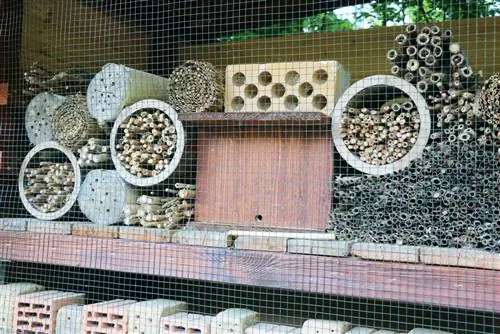
The entrance area in the wild bee house receives protection that repels birds and allows the winged builders to pass through without any problems. Please equip the finished nesting aid with wire mesh or blue plastic net at a distance of 20 cm. A mesh size of 3 x 3 cm is ideal. The net cannot be any tighter, otherwise it will become a death trap for birds and other small animals. In practice it has been shown that birds perceive the color blue from a distance and avoid it.
Tip:
The ideal location for a wild bee house is sunny, warm and protected. Shady areas remain empty, as do nesting aids dangling in treetops.
Convert roof tiles into a wild bee hotel
Strand-interlocking tiles are made of fired clay and have parallel hollow chambers with a diameter of 6 to 8 mm. The classic roof tiles are therefore perfect for constructing a wild bee house. In particular, you can easily breed cavity-dwelling wild bee species, such as the well-known mason bees, in your own garden using these nesting aids. How to do it right:
- Stacking interlocking tiles on a solid surface
- Alternatively include in the construction of a dry stone wall
- Close the openings on one side with plaster, clay or upholstery wool
- Attach protective net or wire mesh at a distance of 20 cm from the opposite side
You can purchase the tiles from roofing companies or directly from the roof tile factory. If listed roofs are re-covered or old barns are torn down, lots of interlocking tiles are produced as waste, which you can get hold of cheaply or for free. The cavities in roof tiles from these sources are often contaminated and are thoroughly cleaned before being used as a nesting aid for wild bees.
As a rule, these bricks are 40 cm too long for a nesting tube. Therefore, use an angle grinder to cut long interlocking tiles in half. The rear end is also closed in this case, because a nesting tube must not be flooded with light.
Use pithy or hollow stems as nesting aids
Some species of wild bees ignore nesting aids made of wood or clay because they prefer pithy stems for raising their brood. To ensure that these species do not go away empty-handed, prudent home gardeners construct a wild bee house using appropriate plants from your garden. The following overview presents the best options for construction in more detail:
mullein (Verbascum)
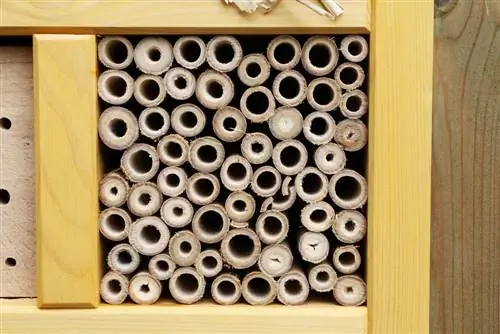
A prime example from the plant kingdom of a wild bee nesting aid are the strong, pithy stems of a mullein. Once the flower has bloomed, cut off the wilted remains. Drive a stick into the ground next to the stem and secure the stem to it with binding wire. The vertical orientation is crucial for its function as a nesting aid. The wild bees remove the pith themselves by gnawing it away.
Blackberry vines
After harvesting, blackberry vines are not disposed of, but are used to build a nesting aid. Place the vines upright along the garden fence with the cut side facing up and tie them tightly. Alternatively, stretch two cords between two posts to arrange the blackberry branches vertically. You can do a similar thing with raspberry canes to offer them as a breeding place for wild bees.
Tip:
Most cavity-dwelling wild bee species produce only one generation per year. It can take up to 12 months before the finished wild bee emerges from a closed nesting tube. The completed wild bee house, including the nesting aids made from plant stems, must not be disturbed over this period if breeding is to be successful.
Bamboo and reeds
Hollow stems are very popular with wild bees to lay their eggs in. Bamboo tubes from the garden center or reed cuttings have proven to work well for this purpose. How to build a wild bee house from it:
- Cut the hollow stems to a length of 10 to 20 cm
- Individually or bundled and placed upright in a container under a rain cover
- Equip with bird protection
The horizontal alignment of hollow and pithy stems as a nesting aid for wild bees has not proven successful. It is also disadvantageous to place plant stems on the ground. The high soil moisture is associated with the risk of fungal infection, so that female wild bees wisely turn down this offer of nesting aid.

